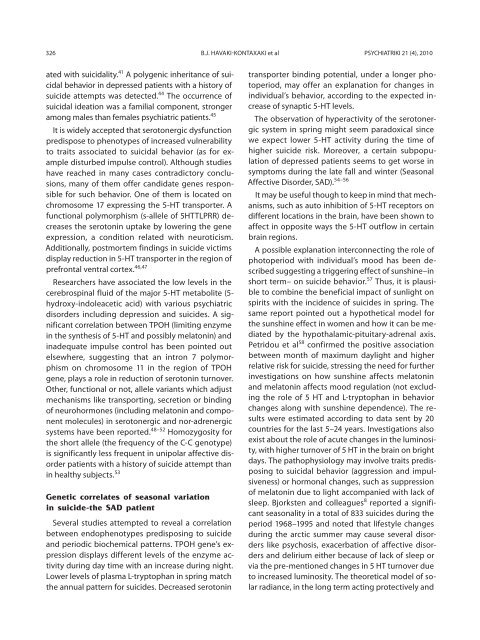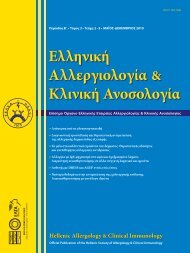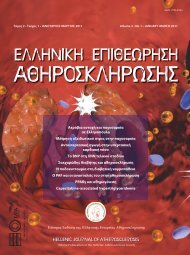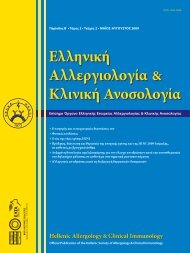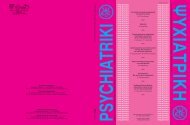326 B.J. HAVAKI-KONTAXAKI et al PSYCHIATRIKI 21 (4), 2010ated with suicidality. 41 A polygenic inheritance of suicidalbehavior in depressed patients with a history ofsuicide attempts was detected. 44 The occurrence ofsuicidal ideation was a familial component, strongeramong males than females psychiatric patients. 45It is widely accepted that serotonergic dysfunctionpredispose to phenotypes of increased vulnerabilityto traits associated to suicidal behavior (as for exampledisturbed impulse control). Although studieshave reached in many cases contradictory conclusions,many of them offer candidate genes responsiblefor such behavior. One of them is located onchromosome 17 expressing the 5-HT transporter. Afunctional polymorphism (s-allele of 5HTTLPRR) decreasesthe serotonin uptake by lowering the geneexpression, a condition related with neuroticism.Additionally, postmortem findings in suicide victimsdisplay reduction in 5-HT transporter in the region ofprefrontal ventral cortex. 46,47Researchers have associated the low levels in thecerebrospinal fluid of the major 5-HT metabolite (5-hydroxy-indoleacetic acid) with various psychiatricdisorders including depression and suicides. A significantcorrelation between TPOH (limiting enzymein the synthesis of 5-HT and possibly melatonin) andinadequate impulse control has been pointed outelsewhere, suggesting that an intron 7 polymorphismon chromosome 11 in the region of TPOHgene, plays a role in reduction of serotonin turnover.Other, functional or not, allele variants which adjustmechanisms like transporting, secretion or bindingof neurohormones (including melatonin and componentmolecules) in serotonergic and nor-adrenergicsystems have been reported. 48–52 Homozygosity forthe short allele (the frequency of the C-C genotype)is significantly less frequent in unipolar affective disorderpatients with a history of suicide attempt thanin healthy subjects. 53Genetic correlates of seasonal variationin suicide-the SAD patientSeveral studies attempted to reveal a correlationbetween endophenotypes predisposing to suicideand periodic biochemical patterns. TPOH gene’s expressiondisplays different levels of the enzyme activityduring day time with an increase during night.Lower levels of plasma L-tryptophan in spring matchthe annual pattern for suicides. Decreased serotonintransporter binding potential, under a longer photoperiod,may offer an explanation for changes inindividual’s behavior, according to the expected increaseof synaptic 5-HT levels.The observation of hyperactivity of the serotonergicsystem in spring might seem paradoxical sincewe expect lower 5-HT activity during the time ofhigher suicide risk. Moreover, a certain subpopulationof depressed patients seems to get worse insymptoms during the late fall and winter (SeasonalAffective Disorder, SAD). 54–56It may be useful though to keep in mind that mechanisms,such as auto inhibition of 5-HT receptors ondifferent locations in the brain, have been shown toaffect in opposite ways the 5-HT outflow in certainbrain regions.A possible explanation interconnecting the role ofphotoperiod with individual’s mood has been describedsuggesting a triggering effect of sunshine–inshort term– on suicide behavior. 57 Thus, it is plausibleto combine the beneficial impact of sunlight onspirits with the incidence of suicides in spring. Thesame report pointed out a hypothetical model forthe sunshine effect in women and how it can be mediatedby the hypothalamic-pituitary-adrenal axis.Petridou et al 58 confirmed the positive associationbetween month of maximum daylight and higherrelative risk for suicide, stressing the need for furtherinvestigations on how sunshine affects melatoninand melatonin affects mood regulation (not excludingthe role of 5 HT and L-tryptophan in behaviorchanges along with sunshine dependence). The resultswere estimated according to data sent by 20countries for the last 5–24 years. Investigations alsoexist about the role of acute changes in the luminosity,with higher turnover of 5 HT in the brain on brightdays. The pathophysiology may involve traits predisposingto suicidal behavior (aggression and impulsiveness)or hormonal changes, such as suppressionof melatonin due to light accompanied with lack ofsleep. Bjorksten and colleagues 8 reported a significantseasonality in a total of 833 suicides during theperiod 1968–1995 and noted that lifestyle changesduring the arctic summer may cause several disorderslike psychosis, exacerbation of affective disordersand delirium either because of lack of sleep orvia the pre-mentioned changes in 5 HT turnover dueto increased luminosity. The theoretical model of solarradiance, in the long term acting protectively and
PSYCHIATRIKI 21 (4), 2010 SEASONALITY, SUICIDALITY AND MELATONIN 327over a short term as a triggering factor for suicide,matches the mechanism of antidepressants whichinitiate a pronounced motivation into the mood beforethey improve the whole spectrum of depressivesymptoms. It is possible thereby, that changes in theweather increase the risk of suicide mainly in individualswith specific vulnerability; even though there isno identification of a “suicide-gene”, certain genesmight interact with each other so as to predisposeto suicidal behavior under the influential role of thephotoperiodic message.The “Low melatonin syndrome”A described hypothetical model for a subgroup ofdepressed individuals involves low nocturnal melatoninlevels along with: (a) abnormal dexamethasonesuppression test, (b) less pronounced periodic alterationsin symptoms, and (c) abnormal 24-h rhythm ofcortisol.Neither the SAD patients, nor the subgroup ofpatients with Low Melatonin Syndrome (LMS) followany specific suicide seasonal pattern. Howeversymptoms correlated with the latter, like anaedoniaand lassitude may incline towards suicidal thoughts;moreover, lower levels of pineal melatonin contentwere found in suicide victims. Some depressed patientssuffering from lassitude and profound sadnesshad lower melatonin levels, albeit in this study havebeen reported higher melatonin maximum levels inparticipants with suicide attempts than ones with nosuicide attempt. 59Seasonality of melatonin levels andinteraction between 5-HT and melatoninIn a sample of 32 depressed outpatients, Carvalhoand colleagues noted alterations in the levels ofa urinary metabolite of melatonin solely in thosewith severe symptoms. 38 The analyzed participantswere drug-free, thus it was possible to exclude theconfounding process of the cytochrome inhibitionby several drugs which may alter the secretion amplitudeof melatonin. Significant peak of suicides,particularly for the age group over 45, have beenobserved in the morning by other investigators. Still,various limitations remain, such as the factor of abnormalsynchronization to the duration of photoperiodin patients who, due to their melancholic symptoms,spend less time outdoors. To make things morecomplicated, the day-length variations over differentseasons of the year may not represent the sameamount of the light exposure for different individualsand populations. Given that illuminance of 60 luxsuppresses melatonin secretion, its onset seems todepend exclusively upon the timing of sleep, as faras individuals in modern life are concerned. Besides,artificial light contains less blue than natural one;considering previous observations that the spectralsensitivity for melatonin regulation is greater for theblue light, it becomes obvious that the time spendingindoors with lights open contributes in a complicated,plus worthy of further understanding, wayto the modulation of the circadian characteristics ofbehavior. 60–63Arendt et al 64 noted that the annual variations ofserum melatonin tend towards an inverse patternwith the levels of platelet 5-HT. Moreover, the 5-HThypothalamic content (probably representing aprecursor for the production rate of melatonin) wasfound 180° out of phase with melatonin content.Administration of melatonin increases serotonin levelsin brain regions and 5-HIAA in cerebrospinal fluid.Numerous publications described low melatoninlevels in spring and suggested a close interconnectionbetween fluctuations of the two indoleamineswith a nadir in 5-HT levels in winter confirming theinverse pattern. 65–68 Among the former, one mayfind enough evidence to hypothesize a bidirectionalinteraction and data contributing to interpretationsfor seasonal phenomena, such as affective disorder,extraordinary impulsivity and suicidal acts.ConclusionThe annual variation in suicide has been inverselyrelated to the annual pattern of melatonin with aspring-peak in suicides and a spring-nadir in melatoninlevels, along with seasonal changes in closelyrelated neurotransmitter systems, mainly those ofserotonin. No profound relationship has emergedamong meteorological conditions and tendencyto suicidal behavior. Socio-epidemiological factorsneed to be taken into account, while the way theintrinsic circadian system interacts with psychiatricconditions remains uncertain. 69,70 Further researchregarding the aetiopathogenesis of suicide in relationto sunlight exposure and rhythmicity of melatoninactivity, might lead to an explanatory modelfor the seasonal distribution of suicide.
- Page 5:
PSYCHIATRIKIQuarterly journal publi
- Page 9 and 10: PSYCHIATRIKI 21 (4), 2010 277Άρθ
- Page 11 and 12: PSYCHIATRIKI 21 (4), 2010 279Resear
- Page 13 and 14: PSYCHIATRIKI 21 (4), 2010 HOSPITAL
- Page 15 and 16: PSYCHIATRIKI 21 (4), 2010 HOSPITAL
- Page 17 and 18: PSYCHIATRIKI 21 (4), 2010 HOSPITAL
- Page 19 and 20: PSYCHIATRIKI 21 (4), 2010 287Resear
- Page 22 and 23: 290 P. TZOURAMANIS et al PSYCHIATRI
- Page 24 and 25: 292 P. TZOURAMANIS et al PSYCHIATRI
- Page 26 and 27: 294 PSYCHIATRIKI 21 (4), 2010Resear
- Page 28 and 29: 296 M. VLASSOPOULOS et al PSYCHIATR
- Page 30 and 31: 298 M. VLASSOPOULOS et al PSYCHIATR
- Page 32 and 33: 300 M. VLASSOPOULOS et al PSYCHIATR
- Page 34 and 35: 302 M. VLASSOPOULOS et al PSYCHIATR
- Page 36 and 37: 304 PSYCHIATRIKI 21 (4), 2010Resear
- Page 38 and 39: 306 H. LAZARATOU et al PSYCHIATRIKI
- Page 40 and 41: 308 H. LAZARATOU et al PSYCHIATRIKI
- Page 42 and 43: 310 H. LAZARATOU et al PSYCHIATRIKI
- Page 44 and 45: 312 H. LAZARATOU et al PSYCHIATRIKI
- Page 46 and 47: 314 H. LAZARATOU et al PSYCHIATRIKI
- Page 48 and 49: 316 C. Kouimtsidis PSYCHIATRIKI 21
- Page 50 and 51: 318 C. Kouimtsidis PSYCHIATRIKI 21
- Page 52 and 53: 320 C. Kouimtsidis PSYCHIATRIKI 21
- Page 54 and 55: 322 C. Kouimtsidis PSYCHIATRIKI 21
- Page 56 and 57: 324 PSYCHIATRIKI 21 (4), 2010Specia
- Page 60 and 61: 328 B.J. HAVAKI-KONTAXAKI et al PSY
- Page 62 and 63: 330 B.J. HAVAKI-KONTAXAKI et al PSY
- Page 64 and 65: 332 PSYCHIATRIKI 21 (4), 2010Genera
- Page 66 and 67: 334 C.I. Istokoglou et al PSYCHIATR
- Page 68 and 69: 336 C.I. Istokoglou et al PSYCHIATR
- Page 70 and 71: 338 C.I. Istokoglou et al PSYCHIATR
- Page 72 and 73: 340 PSYCHIATRIKI 21 (4), 2010• 10
- Page 74 and 75: SUBMISSIONPapers either in English
- Page 76 and 77: ΥΠΟΒΟΛΗ ΕΡΓΑΣΙΩΝΟι
- Page 78: ΣΥΝΟΔΕΥΤΙΚΟ ΕΝΤΥΠΟ


